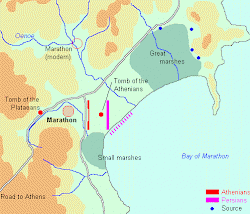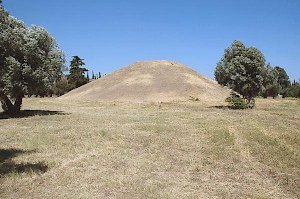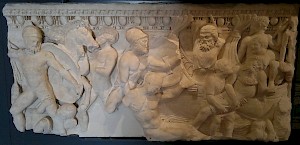Miltiades
Miltiades (c.555-489): Athenian nobleman, commander and politician, famous for his victory at Marathon.

When Miltiades, the son of Cimon, was born, the city of Athens was ruled by a tyrant named Pisistratus. Later traditions presented Miltiades as an opponent of the tyrant and his son Hippias, but this is probably not the whole truth, because we know from an inscription that he occupied the office of archon in 524/523, which suggests that he cooperated with the ruling family. He also belonged to the high court, the areopagus.
In c.520, Miltiades inherited the Chersonese, the peninsula north of Troy and west of the Hellespont. The Greek researcher Herodotus of Halicarnassus, writing in the 430s, tells us that a generation before Miltiades, his uncle Miltiades the Elder had been advised by the oracle of Delphi to accept the government in this country, which was offered to him by an embassy of Chersonesians, who feared the loss of their independence. Together with Athenian settlers, the elder Miltiades had taken over the peninsula. (This can only have happened with support from the Pisistratids.)
He had built a wall across the Chersonese to keep his enemies out, had attacked the city of Lampsacus, had been taken captive, but had been released after a diplomatic intervention by the Lydian king Croesus (c.560-c.547). He had been succeeded by his nephew Stesagoras, who died without children and left the Chersonese to his brother Miltiades the Younger.
Herodotus tells that when Miltiades arrived in the Chersonese, he remained at home as if he were mourning about his brother. When the leaders of the Chersonesians arrived to offer their condolences, he arrested them. A guard of five hundred soldiers is also mentioned, and we know that Miltiades strengthened his position by marrying a Thracian lady named Hegesipyle, the daughter of Olorus.
The chronology of his stay is not fully understood, but the following events seem to have taken place between 520 and 494:
- On one occasion, he was forced to flee for an invasion of a nomadic tribe (Scythians), but returned.
- After he had defeated a band of Scythians or Thracians, he dedicated the spoils in Olympia to the supreme god Zeus. His helmet was found by archaeologists.
- He conquered the islands of Lemnos, Imbros, and Tenedos, which were to remain Athenian.
- He joined the Persian king Darius I the Great when he attacked the Scythians (in 514 or 513). It is unclear whether he did so because he was pressed or because he was simply loyal to his king.
- His family is registered as living in Athens in 507, after the expulsion of Hippias son of Pisistratus.
In 499, the Ionian Greeks revolted against king Darius, and it seems that Miltiades supported them. This is proven by the coins he issued, which show the lion of Miletus, the capital of the rebels. When the Persians suppressed the revolt, Miltiades was in danger, and when the fleet of his enemies approached in 494 or 493, he gave up the Chersonese and fled to Athens. His son Metiochus was captured and deported to Persia, where he seems to have married and lived happily ever after. Miltiades himself settled in Athens. His moment of fame still was to come.
After the Ionian revolt, it was clear to the Persian government that the possessions in Asia Minor could be safe only when the Greeks in the west were subjected as well. Therefore, general Mardonius was sent out to conquer Macedonia (492). His first victim was Macedonia, which he added to the Persian empire. Darius proudly wrote in the inscription on his tomb at Naqš-e Rustam that he had conquered the Yaunâ takabarâ, the 'Greeks with sun hats', a reference to the Macedonian headwear.
Two years later, Darius sent a new expedition to the west. Its commanders were Datis and Artaphernes. Herodotus presents the expedition as a punitive action against Eretria and Athens, who had helped the Ionians during their revolt of 499. But he is almost certainly wrong, because the army was too small to attack Athens. In reality, the aims of the expedition were to add the Aegean islands to the empire and, in doing so, create a buffer zone between Ionia and the Greek mainland. They also tried to bring back the former Pisistrad ruler of Athens, Hippias, to his home town.
The Persians were successful. First, they added Naxos to their empire, the largest island in the Aegean sea, situated in its center. The Greek cult center Delos was seized immediately afterwards; the Greek god Apollo received a giant sacrifice, probably because the Persians identified him with their supreme god Ahuramazda. A few days later, on 1 September 490, Datis and Artaphernes captured Eretria. Its inhabitants were deported to Elam.

Now, the Persians advanced to Marathon, the part of Athenian territory opposite Eretria and an excellent plain for cavalry fight. Some 10,000 heavily armored Athenians, commanded by several strategoi including Miltiades, occupied the road to Athens and a war of nerves started. The Athenians postponed the engagement, waiting for reinforcements. Attacking was impossible, because the Persian cavalry was superior: no infantry line could cross the plain, because its rear would be exposed to attacks by Persian horsemen. Their opponents, on the other hand, were in a hurry, because they knew that the Athenians expected Spartan reinforcements.
One day, Miltiades received favorable omens and moved his army in position. He allowed the center to be weak but strengthened the wings. At dawn, suddenly, he ordered his heavily armored men to run towards their enemies, about two kilometers away. Herodotus remarks that the Persians considered this charge "suicidal madness". On the wings the Athenians, fighting with better armor and longer spears than their enemies, routed the invaders, and after this first victorious engagement, the wings attacked the Persian center in its rear.

According to Herodotus, the Athenians lost 192 men in the ensuing mêlée, their opponents 6,400. This is exaggerated (192×100/3), but no doubt the invaders suffered severely. A German officer, Hauptmann Eschenburg, who visited the plain in 1884/1885, mentions how a Greek farmer had discovered huge masses of human bones, which seemed to belong to hundreds of people. Eschenburg made a short dig and was able to corroborate the statement. The fact that there was no monument whatsoever, seems to suggest that this mass burial was done in a hurry. (That the Athenians buried the Persians was a pious act, but the Persians must have been shocked when they heard about it: it was their practice to expose their dead to the vultures.)
The Athenians and their allies, the Plataeans, received more decent tombs. The tumulus covering the graves of the Athenians is in the middle of the plain and the tomb of the Plataeans can be seen near the small museum at a village called Vrana. It was unusual that Greek warriors were buried on the battle field; the example of this burial must have been the homeric poem the Iliad, where we read how the heroes of the Trojan War received burials on the battle field.

One mystery remains: how could the Athenians cross the plain without fear for a cavalry attack? Herodotus suggests that their charge was too swift, but contradicts this when he says that the struggle was long drawn out. There is, however, another story about this battle, to be found in the biography of Miltiades by the Roman author Cornelius Nepos (first century BCE) and the Suda, a tenth-century Byzantine lexicon. They say that one night, deserters from the Persian army came to the Athenian camp, telling that the cavalry were away.
But why? A possible explanation is that the Persians had become uneasy with the stalemate, had decided to leave the plain to attack the Athenian harbor, and had ordered the cavalry to embark on the transport ships. If this speculation is correct, the Athenians just attacked the Persian rearguard.

Whatever the truth, it is certain that cavalry took part in the final stages of the battle, because at least one Persian horseman was depicted in a contemporary painting representing the battle (in the Athenian building known as Stoa Poikilê). This painting was already lost in 400 CE, but in the Italian town of Brescia, a relief can be seen that is based on it.
After the victory at Marathon, Miltiades lead an attack on the Cyclades, the archipelago that the Persians had recently added to their empire. It was no success: he was wounded and was forced to return to Athens. Here, he was accused by his opponent Xanthippus, and condemned. Miltiades died from gangrene.